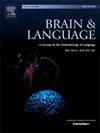Semantic overreliance as a suboptimal compensation for syntactic impairments in children with Developmental Language Disorder
IF 2.3
2区 心理学
Q1 AUDIOLOGY & SPEECH-LANGUAGE PATHOLOGY
引用次数: 0
Abstract
The neurocognitive dynamics of semantic-syntactic interplay are not well understood in children with and without Developmental Language Disorder (DLD). This study examined the N400, P600 and their interplay in Cantonese-speaking children with DLD and age-matched typically developing (TD) children, by manipulating semantic and syntactic violations in Chinese classifier-noun agreement. Behaviorally, children with DLD demonstrated overall lower accuracy in grammaticality judgment. The N400 and P600 analyses respectively confirmed robust semantic processing but attenuated syntactic processing in the DLD group. Crucially, the N400-P600 interplay analyses revealed that TD children prioritized syntactic processing over semantic processing for outright syntactic violations, as indicated by less N400-P600 dependence and robust P600 dominance, whereas children with DLD relied on semantic processing and showed reduced P600 dominance. These results underscore a challenge to prioritize syntactic processing and (suboptimal) compensatory reliance on semantic processing in children with DLD, compatible with the predictions of the Procedural circuit Deficit Hypothesis.
语义过度依赖作为发展性语言障碍儿童句法障碍的次优补偿
在发育性语言障碍(DLD)儿童中,语义-句法相互作用的神经认知动力学尚不清楚。本研究通过操纵汉语分类名词一致性的语义和句法违例,考察了N400、P600及其在粤语儿童和年龄匹配的典型发育(TD)儿童中的相互作用。在行为上,DLD儿童在语法判断上的准确性总体较低。N400和P600分析分别证实了DLD组的语义处理稳健,但句法处理减弱。至关重要的是,N400-P600相互作用分析表明,对于完全违反句法的行为,TD儿童优先考虑句法处理而不是语义处理,这表明N400-P600依赖性较低,P600优势较强,而DLD儿童依赖语义处理,P600优势较弱。这些结果强调了在DLD儿童中优先考虑句法处理和(次优)对语义处理的补偿性依赖的挑战,这与程序回路缺陷假说的预测相一致。
本文章由计算机程序翻译,如有差异,请以英文原文为准。
求助全文
约1分钟内获得全文
求助全文
来源期刊

Brain and Language
医学-神经科学
CiteScore
4.50
自引率
8.00%
发文量
82
审稿时长
20.5 weeks
期刊介绍:
An interdisciplinary journal, Brain and Language publishes articles that elucidate the complex relationships among language, brain, and behavior. The journal covers the large variety of modern techniques in cognitive neuroscience, including functional and structural brain imaging, electrophysiology, cellular and molecular neurobiology, genetics, lesion-based approaches, and computational modeling. All articles must relate to human language and be relevant to the understanding of its neurobiological and neurocognitive bases. Published articles in the journal are expected to have significant theoretical novelty and/or practical implications, and use perspectives and methods from psychology, linguistics, and neuroscience along with brain data and brain measures.
 求助内容:
求助内容: 应助结果提醒方式:
应助结果提醒方式:


